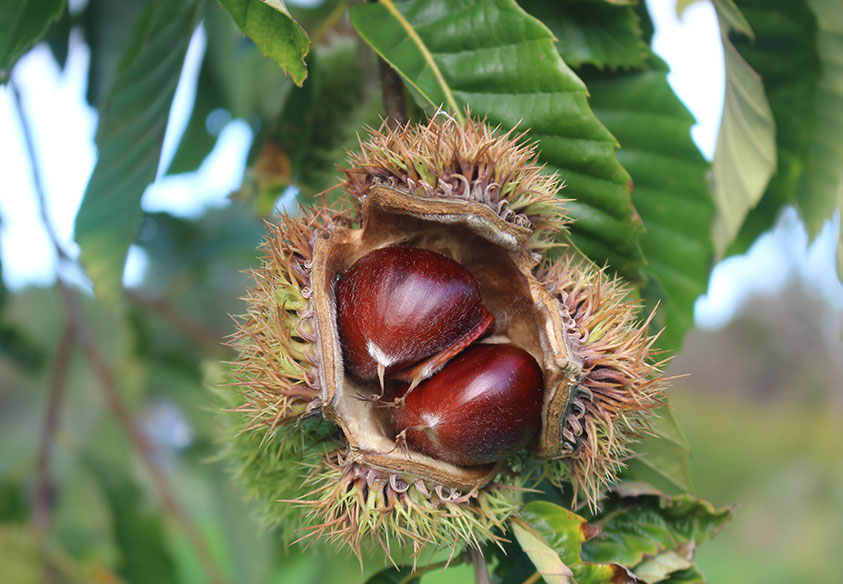In the grand tapestry of American history, there exists a tale of resilience, a story woven by the branches of a once-forgotten giant the American chestnut. Through the ages, this majestic tree faced the ravages of fungal blight and the encroachment of settlers as they pushed westward. Yet, against the odds, the American chestnut is experiencing a renaissance, captivating the imagination and admiration of nature enthusiasts across the nation.
What is the American Chestnut?
Picture a tree that embodies the gardener’s equivalent of the perfect protein an arboreal marvel that not only graces the landscape with its beauty but also plays a crucial role in permaculture gardens. The American chestnut stands as the quinoa of the tree world, offering shade, support to fellow flora, edible fruit with enduring qualities, and unparalleled wood for exquisite furniture.
Despite its historical significance, the American chestnut faced endangerment, reducing its presence to mere pages in history books. However, a dedicated organization, the American Chestnut Foundation, has been on a mission for the past four decades to reintroduce this iconic tree to its native range in the eastern U.S.
How to reintroduce an endangered tree species
The American Chestnut Foundation employs a holistic approach, combining breeding, biotechnology, and biocontrol in a concerted effort known as 3BUR (Breeding, Biotechnology, and Biocontrol United for Restoration). This multifaceted strategy aims to expedite the reintroduction of the American chestnut across its native habitat, seeking collaboration from both scientists and the public to restore this arboreal gem.
The foundation’s vision extends beyond the laboratory and into the hearts of communities. Engaging citizens in the process, they encourage individuals to actively participate in the restoration efforts. By leveraging the collective knowledge and passion of scientists and the public alike, the American Chestnut Foundation envisions a landscape once again adorned with the proud silhouette of the American chestnut.
Identifying American chestnut trees
Distinguishing true American chestnuts from their Chinese counterparts or hybrids is crucial for successful reintroduction. Characteristics such as leaf shape, bud color, and nut release patterns are key identifiers. The American Chestnut Foundation encourages citizen involvement through tree identification guides and sample submissions to local agricultural departments, contributing to the dentataBase database for tracking inventory of wild trees.
Local chapters of the foundation engage with property owners, discussing strategies to maintain or propagate chestnut trees. This includes harvesting open-pollinated seeds or controlled pollination, ultimately contributing to conservation orchards.
The journey to identify and preserve the heritage of the American chestnut involves a shared responsibility. As communities actively participate in this endeavor, a deeper connection to the land and its history is forged. The once-silent forests begin to whisper the tales of these resilient giants, instilling a sense of pride and responsibility among those who tread beneath their branches.
How to use chestnuts in your garden
While chestnut trees are slow growers, their longevity and versatility make them invaluable in permaculture gardens. Resilient to chestnut blight, these trees serve as anchors for transitioning open fields back to thriving forests. Their slow growth allows for the cultivation of shade-loving plants underneath, creating a dynamic ecosystem over time.
Adaptable to climate zones four to eight, chestnuts require a winter chill of 300 to 750 hours below 45 degrees Fahrenheit. Though trees grown from seed may take nearly two decades to mature, nurseries offer grafted alternatives for a quicker yield. The chestnut’s potential to transform landscapes into productive food forests makes it a favorite among permaculture enthusiasts.
Beyond the ecological benefits, the cultivation of chestnut trees becomes a tangible expression of sustainability and interconnectedness with nature. As individuals embark on the journey of nurturing these giants, they contribute not only to their personal gardens but also to the broader landscape, fostering a legacy that transcends generations.
How to be part of the restoration
The loss of the American chestnut remains a poignant ecological disaster, but there is hope. To contribute to the restoration effort, individuals can educate themselves on chestnut tree care and establish their groves by purchasing trees from dedicated farmers. Imagine, in a few years, the aroma of roasted chestnuts wafting through the air an ode to the revival of a natural treasure.
The act of planting a chestnut tree becomes a symbolic gesture an investment in the future and a commitment to the restoration of a once-diminished giant. As these trees take root, they carry with them the aspirations of a community united in its dedication to the environment.
Embracing the Resurgence
In conclusion, the resurgence of the American chestnut is a testament to the enduring spirit of nature and the unwavering commitment of individuals and organizations to restoration. As we witness the return of this iconic tree, let us embrace the opportunity to be stewards of its legacy, ensuring that the American chestnut thrives once again in the heart of our landscapes.
With every tree planted, every bud identified, and every story shared, we contribute to a narrative of revival a story of hope, resilience, and the triumphant return of the American chestnut to its rightful place in the natural tapestry of America. As stewards of this legacy, we hold the key to a future where the American chestnut stands tall, casting its shade on generations yet to come.

